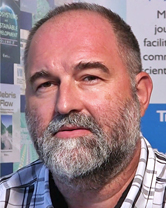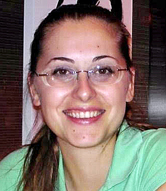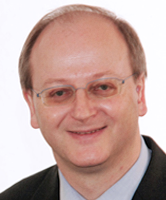Various Aspects of Interaction of Humans with Electromagnetics Fields(Tutorial)
Paper presentation:
- Integral Equation Models in Some Biomedical Applications of Electromagnetic Fields; Transcranial magnetic stimulation (TMS), Nerve fiber stimulation
Dragan Poljak, Mario Cvetković, Vicko Doric, Ivana Zulim, Zoran Đogaš, and Maja Rogic (University of Split, Croatia); Jens Haueisen (Technical University Ilmenau, Germany); Khalil El Khamlichi Drissi (Universite Blaise Pascal & LASMEA Laboratory, France)
The paper reviews certain integral equation formulations and related numerical solution methods used in studies of biomedical applications of electromagnetic fields related to transcranial magnetic stimulation (TMS) and nerve fiber stimulation. TMS is modeled via the set of coupled surface integral equations (SIEs), while the numerical solution of governing equations is undertaken via an efficient Method of Moments (MoM) scheme. A myelinated nerve fiber, stimulated by a current generator, is represented by a straight thin wire antenna. The model is based on the corresponding homogeneous Pocklington integro-diferential equation numerically solved via the Galerkin Bubnov Indirect Boundary Element Method (GB-IBEM). Some illustrative numerical results for the TMS induced fields and intracellular current distribution along the myelinated nerve fiber (active and passive), respectively, is obtained.
TUTORIAL
Human exposure to radiation from Electromagnetic Interference (EMI) sources
by Dragan Poljak
The scope of this part of the Tutorial is to give various aspects of human exposure to undesired electromagnetic radiation from artificial sources thus covering; basic ideas of electrosmog, coupling mechanisms between humans and electromagnetic fields, dosimetry methods, international/national safety guidelines, relevant exposure limits and safety measures. First, some theoretical and experimental techniques of incident field dosimetry for the determination of external fields due to power lines, transformer substations, radio base station antennas and mobile phones are analyzed. Furthermore, the presentation aims to review some electromagnetic-thermal dosimetry methods for the assessment of human exposure to low frequency (LF) and high frequency (HF) non-ionizing electromagnetic fields. In particular, the analysis approaches are based on certain integral/differential equation formulations and related numerical solution procedures (based on the use of Boundary Element Method – BEM, and Finite Element method – FEM) for the calculation of induced current densities and fields, specific absorption rate (SAR) and related temperature increase in a tissue. Illustrative computational examples pertaining to some realistic exposure scenarios, such as; pregnant woman/foetus exposed to low frequency (LF) fields, the human eye and the human brain exposed to HF electromagnetic fields will be given.
Also, some numerical results for the nerve fiber stimulation will be presented as an example of biomedical application of electromagnetic fields. The obtained numerical results for induced current densities, internal fields and SAR are compared against exposure limits proposed by ICNIRP (International Commission on Non Ionizing Radiation Protection).
Biomedical application of EMF: Transcranial Magnetic Stimulation from two perspectives
by Mario Cvetković and Maja Rogić Vidaković
1. Engineering/Numerical Analysis point of view
2. Medical/Neuroscience point of view
Along the adverse effects due to unwanted exposure scenarios, the electromagnetic fields (EMF) are nowadays also applied to various therapeutic and diagnostic purposes. At the moment, one of a very interesting biomedical application of EMF is a technique known as transcranial magnetic stimulation (TMS), a noninvasive and generally painless way for achieving excitation or inhibition of cortical brain areas. TMS is used in various fields such as neurology, neurosurgery, neurophysiology, neuroscience and psychiatry. Navigated transcranial magnetic stimulation (nTMS) is today a standard technique in preoperative mapping of primary motor cortices in patients undergoing awake brain surgery. Also, great emphasis is now placed on development of neurophysiologic nTMS methodologies for mapping higher cognitive functions like speech and language.
The TMS technique involves specifically designed coils positioned on the subject's/patients scalp that, when energized by a short but intense current pulse,
generates a changing magnetic field which penetrates through the skull and scalp and in turn induced electric field in the brain within several centimeters of outer cortex. If the value of electric field reaches a threshold value, it causes activation within specific region.
Although the variable efficiency of TMS stimulation can be primarily attributed to differences in relevant TMS settings such as coil positioning, pulse waveform, frequency, number of stimuli and the intensity of stimulation, the obvious difference in brain size between the individuals, as well as the biological tissue parameters such as permittivity and the electrical conductivity needs to be taken into account, since these parameters may affect the distribution of the induced electric fields in the brain. TMS modelling can aid in determining the exact location of stimulation, in the interpretation of experimental results and in designing more efficient stimulation setups. Numerical model of a TMS can provide TMS investigator with a more reliable prediction of the induced fields and currents.
The presentation will give two complementary views of a TMS: the one from the side of a medical expert/researcher using nTMS in preoperative evaluation of patients undergoing neurosurgical operation, development of nTMS methodologies for mapping higher brain functions, and studying neurophysiologic mechanisms of speech and language generation and disorders. The second presentation will be given from a perspective of numerical analyst/engineer working on the development of a rigorous, and hence more exact simulation models for TMS. The results from both sides of TMS usage work will be presented in addition to some insights on future development.
New sensors and modeling approaches for Electroencephalography
by Jens Haueisen
Multichannel Electroencephalography (EEG) and Magnetoencephalography (MEG) are widely used in clinical neurology and neuroscientific research. EEG caps with wet Silver/Silver-Chloride (Ag/AgCl) electrodes represent an often-used standard in the field. Reproducible electrode-skin contact for these electrodes is ensured by electrolyte gel or paste. Thus, these electrodes require specific mechanisms to apply and hold the gel at the electrode positions in the caps and require skilled personnel to apply the EEG cap. Dry electrodes allow more degrees of freedom in the design and fabrication of EEG caps and can be self-applied without long preparation times.
This talk will present novel multi-channel EEG caps with dry electrodes. The base material of the EEG cap is a light-weight and flexible fabric, which contains small holes (perforation) making it breathable. Polyurethane (PU) based multi-pin electrodes serve as novel dry contact electrodes. A coating provides electrical conductivity of these polymer based electrodes. The use of silver coating opens the way for dry AgCl electrodes and thus, signal quality similar to wet Ag/AgCl electrodes. Our results demonstrate that resting state EEG, eye movements, alpha activity, and pattern reversal VEP can be recorded with a novel dry multi-channel EEG cap without long preparation times and without significant differences between the novel EEG cap and a conventional cap based on wet Ag/AgCl electrodes. In the second part of the talk, source reconstruction based on the EEG data will be addressed. In order to reconstruct the neuronal activity underlying measured EEG data both the forward problem (computing the electromagnetic field due to given sources) and the inverse problem (finding the best fitting sources to explain given data) have to be solved. The forward problem involves a source model and a model with the conductivities of the head. The conductivity model can be as simple as a homogeneously conducting sphere or as complex as a finite element model consisting of millions of elements, each with a different anisotropic conductivity tensor.
The question is addressed how complex the employed forward model should be, and, more specifically, the influence of anisotropic volume conduction and the influence of conductivity inhomogeneities are evaluated.
Moreover, validation of forward computations using high-resolution finite element method (FEM) modelling is presented. For this purpose high resolution FEM models of the rabbit and the human head are employed in combination with individual conductivity tensors to quantify the influence of white matter anisotropy on the solution of the forward and inverse problem in EEG and MEG. Although the current state of the art in the analysis of this influence of brain tissue anisotropy on source reconstruction does not yet allow a final conclusion, the results available indicate that the expected average source localization error due to anisotropic white matter conductivity might be within the principal accuracy limits of current inverse procedures. However, in some percent of the cases a considerably larger localization error might occur. In contrast, dipole orientation and dipole strength estimation are influenced significantly by anisotropy.
In conclusion, we introduce a novel type of sensor for EEG and demonstrate a validation of state of the art FEM modelling for EEG/MEG source reconstruction procedures and a source localization accuracy in the sub-millimeter range. FEM models can improve EEG/MEG based localization of neuronal activity.
Human Body Models for Numerical Dosimetry and Biomedical Applications
by Valerio De Santis
Numerical simulations are increasingly used to investigate both the impact of external electromagnetic fields on the human body and for medical applications, thereby complementing experimental studies. In the long term, the significance of numerical evaluations performed with computational human models can be expected to outweigh experimental studies. In this tutorial, an overview of human body models specifically developed for numerical dosimetry and biomedical applications will be envisaged. After a brief historical overview, the comparison between voxel-based models coming from MRI or CT image scans versus more complex CAD models will be presented. Automated vs. semi-automated segmentation procedures to develop these models will also be addressed. Finally, basic concepts on how to assign the right material properties to the several biological tissues will be undertaken.





